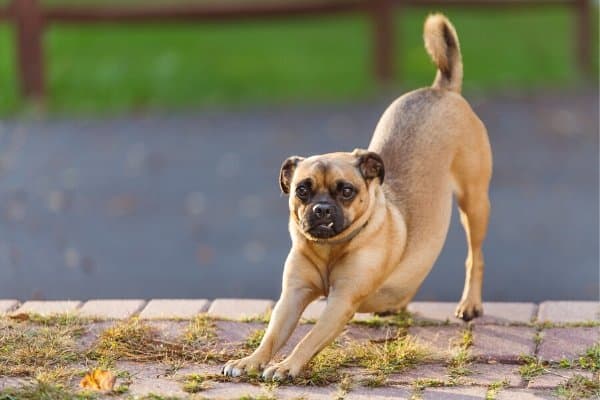When you are imagining your perfect dog, do you find yourself seeing the incredibly adorable squishy face of a Puggle? Puggles are truly very cute and they tend to have charming personalities, but will you be able to give a Puggle enough exercise?
Perhaps you’re wondering if a Puggle can keep up with you. Here’s what you need to know about exercise for this playful, wrinkly, breed.
How much exercise does a Puggle need? Even if they take after the more energetic Beagle parent, Puggles only need about an hour of exercise a day at most to be healthy and happy. It is best if their exercise is divided up into morning and evening sessions, especially if your Puggle has a shorter snout.
How much exercise does a Puggle need?
Puggles don’t need nearly as much exercise as many dog breeds. If your Puggle takes after their Pug parent, they may need very little active exercise. However, your Puggle may need more exercise if they take after the Beagle in their heritage.
To understand how much exercise a Puggle needs, you must first have a sense of how much exercise their parent breeds, the Pug and the Beagle, require.
Pug exercise needs
According to the AKC, the Pug has regular exercise needs. The breed is happy to spend most of the day on the sofa, which, combined with their tendency to eat as much as possible, can easily lead to obesity in the breed.
In order to keep the pounds off and keep Pugs fit and lively, daily walks or play sessions in the yard are sufficient. Pugs are known to be an excellent city or suburban dog, content with a nice stroll at the end of the day and play inside the home.
Beagle exercise needs
Beagles are considerably more energetic than Pugs. The AKC recommends at least an hour of exercise every day for Beagles. For most Beagles, running around in the backyard isn’t good enough. The AKC recommends at least an hour of exercise a day. Beagles were bred to run for hours after prey, and most are more than happy for the opportunity for an extended run, especially if they get to follow their noses.
Puggle exercise needs
Your Puggle may need anywhere from about half an hour to an hour of exercise a day. Both the Beagle and the Pug are known for their love of food, which may lead to obesity in the Puggle. It is important that you offer your Puggle enough exercise to keep them at an ideal weight, but be careful to avoid heat and humidity, especially for short-snouted Puggles.
How often should you walk a Puggle?
It is best to walk your Puggle at least twice a day, and most Puggles appreciate a 3rd or 4th walk as well. It is important not to walk your Puggle for too long.
Instead, divide walking sessions into shorter periods, especially if your dog ever becomes winded or struggles to breathe on walks. If it is too hot or humid, skip the walk and play with your Puggle inside instead, only taking them outside long enough to release themselves.
How to exercise a Puggle
Your dog’s preferences for exercise may vary depending on the characteristics that they have inherited from their parents. Short faced Puggles who take after their Pug parent may be intolerant of hot weather and should never exercise vigorously when it is humid or warm out.
Puggles with longer snouts, on the other hand, may excel in all the warm weather activities that Beagles love. Here are some activities that will likely be good picks for your Puggle.
Water play
Studies have found many Pugs to have an abnormal gait, and several studies have found that short-legged dogs like the Pug are predisposed to orthopedic conditions such as luxating patella. Playing in the water gives your Puggle the opportunity to exercise without straining their joints.
Too and potentially more importantly, playing in the water strengthens the muscles around the joints, which may keep your dog from becoming symptomatic for joint issues for longer. Moreover, the water helps to keep your Puggle from overheating, which can be a serious danger for short-snouted Puggles.
A Puggle might not be the best swimmer, so it’s recommended that they have a life vest for added safety. This vest is an extremely popular choice among dog owners.
Play with other dogs
Beagles are well known for their sociability. Bred to live and work with other dogs, Beagles are friendly with not just other Beagles but all kinds of dogs big and small.
Pugs may be less likely to get along well with other dogs, but they are not unsociable by any means. Most pugs get along fine with other dogs, provided the other dogs are respectful of them and don’t push them to play when they don’t want to.
Therefore, the dog park is an excellent way to exercise your Puggle. Because Puggles are smaller dogs, it is essential that you only choose playmates that are the same size or smaller than your puggle, and that you are very aware of potential dangers.
That said, playing with other dogs is a great way to exercise your Puggle, and one of the activities that require the least effort from you.
Walking and light jogging
Beagles were made to run, and Pugs generally enjoy a stroll as well, so you can assume that your Puggle will appreciate some level of activity between walking and jogging. You don’t want to stress your Puggle’s joints, so it is best to run on soft ground like dirt and grass and choose to walk when you need to cover the hard concrete or asphalt.
What NOT to do when exercising your Puggle
Now that we’ve looked into activities that are a great fit for Puggles, let’s examine some things that you should stay away from. This adorable breed has some special needs which means that certain types of activity may not be as safe for them as they are for other dogs.
Exercise that may hurt the spine
Unfortunately, a fair number of Pugs are affected with deformities of the spine which can lead to pressure on the spinal cord and eventual paralysis. Genetics predisposes dogs to this condition. It may be more likely in individuals who have a curly tail, so if your Puggle has a curly tail you should be especially watchful of back issues.
Some dogs will develop symptoms regardless of their lifestyle and others won’t have problems no matter what they do throughout their life, but at least a certain number of dogs are likely to have symptoms come out as a result of lifestyle. For that reason, it is essential that whatever exercise you choose for your Puggle, keep their spine in mind.
Leave them alone in the yard
Beagles are escape artists who long to be with people and other dogs and hate being left alone. Therefore, you cannot expect to leave a Puggle alone in the backyard.
If they take after their Beagle parent, they won’t take long to climb or dig underneath the fence and find someone to play with or a great scent to follow.
Let them off-leash unless in a fenced and safe area
Neither Pugs nor Beagles are particularly well-known for their obedience. Beagles, like most hounds, are more likely to follow their nose than your commands.
Beagles bay so that the hunters on horseback can hear where they are and keep up with them. The white tips of their tails are in order to see the dogs as they run away.
Everything in a beagle’s nature tells it to run and let you follow. You can expect to see the end of your Puggles’ tail, whether white-tipped or curly, if you let them off-leash, so on-leash activities or free play in fenced areas is recommended.
If you want them to have some extra freedom, use a long lead like this 50-foot one.
Related Questions
What if my Puggle is still bored?
If you find that your Puggle is still bored after what should be sufficient exercise, try entertaining them with a food distributing toy or play interactive games in your home. Some dogs need more mental stimulation even if they are getting as much exercise as is good for them.
Teach your Puggle cute tricks, build their self-control with “stay” training and games, and play games like hide and seek that occupy the hound dog nose from their beagle parent.
Do Puggles need a lot of exercise?
Compared to a lot of breeds, including breeds of similar size, Puggles don’t need much exercise at all. An hour a day may sound like a lot, but it is important to keep in mind that this should be divided up into at least two or possibly three walks.
Furthermore, only the most energetic Puggles who are most similar to their Beagle parents will need as much as an hour a day. For the most part, Puggles don’t need a lot of exercise.





